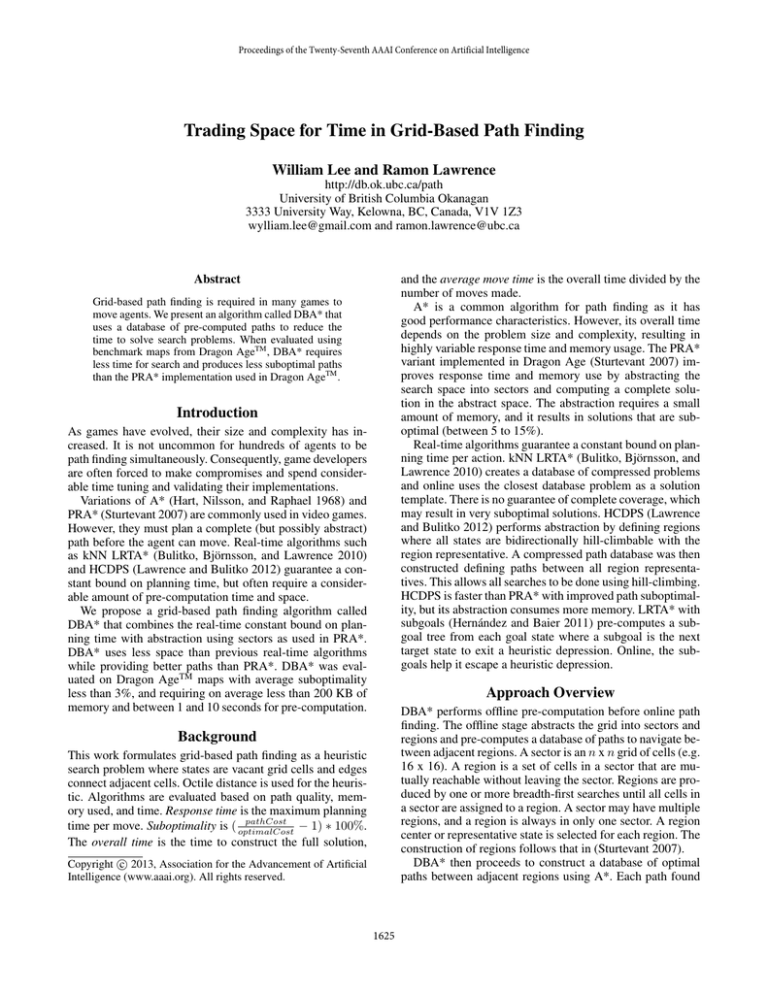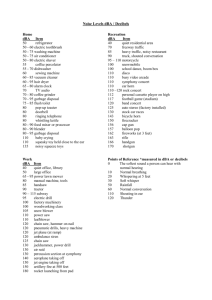
Proceedings of the Twenty-Seventh AAAI Conference on Artificial Intelligence
Trading Space for Time in Grid-Based Path Finding
William Lee and Ramon Lawrence
http://db.ok.ubc.ca/path
University of British Columbia Okanagan
3333 University Way, Kelowna, BC, Canada, V1V 1Z3
wylliam.lee@gmail.com and ramon.lawrence@ubc.ca
and the average move time is the overall time divided by the
number of moves made.
A* is a common algorithm for path finding as it has
good performance characteristics. However, its overall time
depends on the problem size and complexity, resulting in
highly variable response time and memory usage. The PRA*
variant implemented in Dragon Age (Sturtevant 2007) improves response time and memory use by abstracting the
search space into sectors and computing a complete solution in the abstract space. The abstraction requires a small
amount of memory, and it results in solutions that are suboptimal (between 5 to 15%).
Real-time algorithms guarantee a constant bound on planning time per action. kNN LRTA* (Bulitko, Björnsson, and
Lawrence 2010) creates a database of compressed problems
and online uses the closest database problem as a solution
template. There is no guarantee of complete coverage, which
may result in very suboptimal solutions. HCDPS (Lawrence
and Bulitko 2012) performs abstraction by defining regions
where all states are bidirectionally hill-climbable with the
region representative. A compressed path database was then
constructed defining paths between all region representatives. This allows all searches to be done using hill-climbing.
HCDPS is faster than PRA* with improved path suboptimality, but its abstraction consumes more memory. LRTA* with
subgoals (Hernández and Baier 2011) pre-computes a subgoal tree from each goal state where a subgoal is the next
target state to exit a heuristic depression. Online, the subgoals help it escape a heuristic depression.
Abstract
Grid-based path finding is required in many games to
move agents. We present an algorithm called DBA* that
uses a database of pre-computed paths to reduce the
time to solve search problems. When evaluated using
benchmark maps from Dragon AgeTM , DBA* requires
less time for search and produces less suboptimal paths
than the PRA* implementation used in Dragon AgeTM .
Introduction
As games have evolved, their size and complexity has increased. It is not uncommon for hundreds of agents to be
path finding simultaneously. Consequently, game developers
are often forced to make compromises and spend considerable time tuning and validating their implementations.
Variations of A* (Hart, Nilsson, and Raphael 1968) and
PRA* (Sturtevant 2007) are commonly used in video games.
However, they must plan a complete (but possibly abstract)
path before the agent can move. Real-time algorithms such
as kNN LRTA* (Bulitko, Björnsson, and Lawrence 2010)
and HCDPS (Lawrence and Bulitko 2012) guarantee a constant bound on planning time, but often require a considerable amount of pre-computation time and space.
We propose a grid-based path finding algorithm called
DBA* that combines the real-time constant bound on planning time with abstraction using sectors as used in PRA*.
DBA* uses less space than previous real-time algorithms
while providing better paths than PRA*. DBA* was evaluated on Dragon AgeTM maps with average suboptimality
less than 3%, and requiring on average less than 200 KB of
memory and between 1 and 10 seconds for pre-computation.
Approach Overview
DBA* performs offline pre-computation before online path
finding. The offline stage abstracts the grid into sectors and
regions and pre-computes a database of paths to navigate between adjacent regions. A sector is an n x n grid of cells (e.g.
16 x 16). A region is a set of cells in a sector that are mutually reachable without leaving the sector. Regions are produced by one or more breadth-first searches until all cells in
a sector are assigned to a region. A sector may have multiple
regions, and a region is always in only one sector. A region
center or representative state is selected for each region. The
construction of regions follows that in (Sturtevant 2007).
DBA* then proceeds to construct a database of optimal
paths between adjacent regions using A*. Each path found
Background
This work formulates grid-based path finding as a heuristic
search problem where states are vacant grid cells and edges
connect adjacent cells. Octile distance is used for the heuristic. Algorithms are evaluated based on path quality, memory used, and time. Response time is the maximum planning
pathCost
− 1) ∗ 100%.
time per move. Suboptimality is ( optimalCost
The overall time is the time to construct the full solution,
c 2013, Association for the Advancement of Artificial
Copyright Intelligence (www.aaai.org). All rights reserved.
1625
is stored in compressed format by storing a sequence of subgoals, each of which can be reached from the previous subgoal via hill-climbing. Hill-climbing compressible paths are
described in (Bulitko, Björnsson, and Lawrence 2010).
To navigate between non-adjacent regions, an R x R matrix (where R is the number of regions) is constructed where
cell (i, j) contains the next region to visit on a path from Ri
to Rj , the path cost, and the path itself (if the two regions
are adjacent). The matrix is initialized with the paths between adjacent regions, and dynamic programming is used
to determine the costs and next region for all cells.
Given the start and goal, the region for the start Rs and
for the goal Rg is known if there is only one region in the
sector, or calculated using a sector bounded BFS. The path
matrix is used to build a path between Rs and Rg . This path
may be stored in the database if the regions are adjacent, or it
is the concatenation of paths by navigating through adjacent
regions from Rs to Rg . The complete path consists of navigating from s to the region representative Rs , then following
the subgoals to region representative Rg , then to g.
The response time is minimal as the agent can navigate
from s to the start region representative Rs as soon as the
BFS is completed. The complete path between regions is iterative with the agent following the subgoals in a path from
one region to the next without constructing the entire path.
DragonAge:OriginsMaps
Suboptimality(%)
100.00%
PRA*
HCDPS
DBA*16
10.00%
DBA*32
DBA*64
DBA*128
1.00%
1.00
10.00
100.00
sgLRTA*
Movetime(μs)
Figure 1: Suboptimality versus Move Time
DragonAge:OriginsMaps
Suboptimality(%)
100.00%
PRA*
HCDPS
DBA*16
10.00%
DBA*32
DBA*64
Experimental Results
DBA*128
sgLRTA*
1.00%
Algorithms were evaluated on ten standard benchmark maps from Dragon Age: OriginsTM (available at
http://movingai.com), which have an average number of
open states of 96,739 and total cells of 574,132. For each
map, 100 sample problems were run from the problem
set. The algorithms compared were DBA*, PRA* as implemented in Dragon Age (Sturtevant 2007), HCDPS, and
LRTA* with subgoals (Hernández and Baier 2011). HCDPS
was run for neighborhood depth L = {1, 2, 3, 4}. PRA* was
run for sector sizes of 16 x 16, 32 x 32, 64 x 64, and 128 x
128. DBA* was run under all combinations of parameters.
Figure 1 displays suboptimality versus move time, and
Figure 2 displays suboptimality versus memory used. Each
point represents an algorithm with a different configuration.
For PRA*, there are 4 points corresponding to 16, 32, 64,
and 128 sector sizes. HCDPS has 4 points corresponding to
L = {1, 2, 3, 4}. For DBA*, there are separate series for
each sector size (16, 32, 64, 128), and each series consists of
4 points corresponding to L = {1, 2, 3, 4}. DBA* variants
are generally faster with better suboptimality than HCDPS
and PRA*. Larger sector sizes for both DBA* and PRA*
hurt suboptimality and increase time, but with a much larger
effect for PRA* because the quality of the abstraction is poor
for larger sector sizes and the problem space is not significantly reduced in size. Since DBA* uses its path database
rather than solving using A* in the abstract space, its move
time and suboptimality does not increase as much with
larger sectors. LRTA* with subgoals (shown as sgLRTA*) is
almost optimal with a relatively high move time. DBA* consumes less memory than sgLRTA* and HCDPS* but slightly
more than PRA*.
1
100
10000
Totalmemory(kBytes)
1000000
Figure 2: Suboptimality versus Total Memory Used
Conclusions and Future Work
DBA* has lower suboptimality than other abstraction-based
approaches with a faster response time. It represents a quality balance and integration of the best features of previous
algorithms. Future work includes defining techniques for efficiently updating pre-computed data to reflect grid changes.
References
Bulitko, V.; Björnsson, Y.; and Lawrence, R. 2010. Casebased subgoaling in real-time heuristic search for video
game pathfinding. JAIR 39:269–300.
Hart, P.; Nilsson, N.; and Raphael, B. 1968. A formal basis
for the heuristic determination of minimum cost paths. IEEE
Trans. on Systems Science and Cybernetics 4(2):100–107.
Hernández, C., and Baier, J. A. 2011. Real-time heuristic
search with depression avoidance. In IJCAI, 578–583.
Lawrence, R., and Bulitko, V. 2012. Database-driven
real-time heuristic search in video-game pathfinding. IEEE
TCAIG PP(99).
Sturtevant, N. 2007. Memory-efficient abstractions for
pathfinding. In AIIDE, 31–36.
1626







